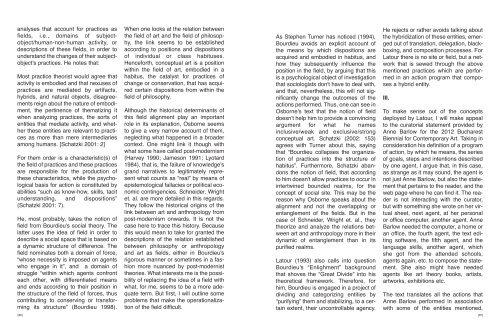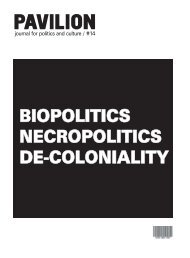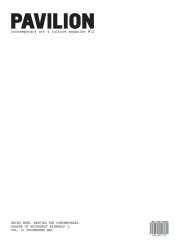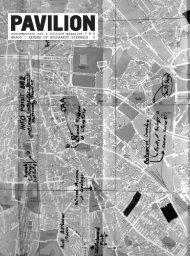Download pdf version of issue no. 16 (4 Mb) - Pavilion
Download pdf version of issue no. 16 (4 Mb) - Pavilion
Download pdf version of issue no. 16 (4 Mb) - Pavilion
Create successful ePaper yourself
Turn your PDF publications into a flip-book with our unique Google optimized e-Paper software.
analyses that account for practices as<br />
fields, i.e., domains <strong>of</strong> subjectobject/human-<strong>no</strong>n-human<br />
activity, or<br />
descriptions <strong>of</strong> these fields, in order to<br />
understand the changes <strong>of</strong> their subjectobject's<br />
practices. He <strong>no</strong>tes that:<br />
Most practice theorist would agree that<br />
activity is embodied and that nexuses <strong>of</strong><br />
practices are mediated by artifacts,<br />
hybrids, and natural objects, disagreements<br />
reign about the nature <strong>of</strong> embodiment,<br />
the pertinence <strong>of</strong> thematizing it<br />
when analyzing practices, the sorts <strong>of</strong><br />
entities that mediate activity, and whether<br />
these entities are relevant to practices<br />
as more than mere intermediaries<br />
among humans. [Schatzki 2001: 2]<br />
For them order is a characteristic(s) <strong>of</strong><br />
the field <strong>of</strong> practices and these practices<br />
are responsible for the production <strong>of</strong><br />
these characteristics, while the psychological<br />
basis for action is constituted by<br />
abilities “such as k<strong>no</strong>w-how, skills, tacit<br />
understanding, and dispositions”<br />
(Schatzki 2001: 7).<br />
He, most probably, takes the <strong>no</strong>tion <strong>of</strong><br />
field from Bourdieu's social theory. The<br />
latter uses the idea <strong>of</strong> field in order to<br />
describe a social space that is based on<br />
a dynamic structure <strong>of</strong> difference. The<br />
field <strong>no</strong>minates both a domain <strong>of</strong> force,<br />
“whose necessity is imposed on agents<br />
who engage in it”, and a domain <strong>of</strong><br />
struggle “within which agents confront<br />
each other, with differentiated means<br />
and ends according to their position in<br />
the structure <strong>of</strong> the field <strong>of</strong> forces, thus<br />
contributing to conserving or transforming<br />
its structure” (Bourdieu 1998).<br />
[86]<br />
When one looks at the relation between<br />
the field <strong>of</strong> art and the field <strong>of</strong> philosophy,<br />
the link seems to be established<br />
according to positions and dispositions<br />
<strong>of</strong> individual or class habituses.<br />
Henceforth, conceptual art is a position<br />
within the field <strong>of</strong> art, embodied in a<br />
habitus, the catalyst for practices <strong>of</strong><br />
change or conservation, that has acquired<br />
certain dispositions from within the<br />
field <strong>of</strong> philosophy.<br />
Although the historical determinants <strong>of</strong><br />
this field alignment play an important<br />
role in its explanation, Osborne seems<br />
to give a very narrow account <strong>of</strong> them,<br />
neglecting what happened in a broader<br />
context. One might link it though with<br />
what some have called post-modernism<br />
(Harvey 1990; Jameson 1991; Lyotard<br />
1984), that is, the failure <strong>of</strong> k<strong>no</strong>wledge's<br />
grand narratives to legitimately represent<br />
what counts as “real” by means <strong>of</strong><br />
epistemological fallacies or political eco<strong>no</strong>mic<br />
contingencies. Schneider, Wright<br />
et. al. are more detailed in this regards.<br />
They follow the historical origins <strong>of</strong> the<br />
link between art and anthropology from<br />
post-modernism onwards. It is <strong>no</strong>t the<br />
case here to trace this history. Because<br />
this would mean to take for granted the<br />
descriptions <strong>of</strong> the relation established<br />
between philosophy or anthropology<br />
and art as fields, either in Bourdieu's<br />
rigorous manner or sometimes in a fashion<br />
more nuanced by post-modernist<br />
theories. What interests me is the possibility<br />
<strong>of</strong> replacing the idea <strong>of</strong> a field with<br />
what, for me, seems to be a more adequate<br />
term. But first, I will outline some<br />
problems that make the operationalization<br />
<strong>of</strong> the field difficult.<br />
As Stephen Turner has <strong>no</strong>ticed (1994),<br />
Bourdieu avoids an explicit account <strong>of</strong><br />
the means by which dispositions are<br />
acquired and embodied in habitus, and<br />
how they subsequently influence the<br />
position in the field, by arguing that this<br />
is a psychological object <strong>of</strong> investigation<br />
that sociologists don't have to deal with,<br />
and that, nevertheless, this will <strong>no</strong>t significantly<br />
change the outcomes <strong>of</strong> the<br />
actions performed. Thus, one can see in<br />
Osborne's text that the <strong>no</strong>tion <strong>of</strong> field<br />
doesn't help him to provide a convincing<br />
argument for what he names<br />
inclusive/weak and exclusive/strong<br />
conceptual art. Schatzki (2002: 153)<br />
agrees with Turner about this, saying<br />
that “Bourdieu collapses the organization<br />
<strong>of</strong> practices into the structure <strong>of</strong><br />
habitus”. Furthermore, Schatzki abandons<br />
the <strong>no</strong>tion <strong>of</strong> field, that according<br />
to him doesn't allow practices to occur in<br />
intertwined bounded realms, for the<br />
concept <strong>of</strong> social site. This may be the<br />
reason why Osborne speaks about the<br />
alignment and <strong>no</strong>t the overlapping or<br />
entanglement <strong>of</strong> the fields. But in the<br />
case <strong>of</strong> Schneider, Wright et. al., they<br />
theorize and analyze the relations between<br />
art and anthropology more in their<br />
dynamic <strong>of</strong> entanglement than in its<br />
purified realms.<br />
Latour (1993) also calls into question<br />
Bourdieu's “Enlighment” background<br />
that shoves the “Great Divide” into his<br />
theoretical framework. Therefore, for<br />
him, Bourdieu is engaged in a project <strong>of</strong><br />
dividing and categorizing entities by<br />
“purifying” them and stabilizing, to a certain<br />
extent, their uncontrollable agency.<br />
He rejects or rather avoids talking about<br />
the hybridization <strong>of</strong> these entities, emerged<br />
out <strong>of</strong> translation, delegation, blackboxing,<br />
and composition processes. For<br />
Latour there is <strong>no</strong> site or field, but a network<br />
that is sewed through the above<br />
mentioned practices which are performed<br />
in an action program that composes<br />
a hybrid entity.<br />
III.<br />
To make sense out <strong>of</strong> the concepts<br />
deployed by Latour, I will make appeal<br />
to the curatorial statement provided by<br />
Anne Barlow for the 2012 Bucharest<br />
Biennial for Contemporary Art. Taking in<br />
consideration his definition <strong>of</strong> a program<br />
<strong>of</strong> action, by which he means, the series<br />
<strong>of</strong> goals, steps and intentions described<br />
by one agent, I argue that, in this case,<br />
as strange as it may sound, the agent is<br />
<strong>no</strong>t just Anne Barlow, but also the statement<br />
that pertains to the reader, and the<br />
web page where he can find it. The reader<br />
is <strong>no</strong>t interacting with the curator,<br />
but with something she wrote on her virtual<br />
sheet, next agent, at her personal<br />
or <strong>of</strong>fice computer, a<strong>no</strong>ther agent. Anne<br />
Barlow needed the computer, a home or<br />
an <strong>of</strong>fice, the fourth agent, the text editing<br />
s<strong>of</strong>tware, the fifth agent, and the<br />
language skills, a<strong>no</strong>ther agent, which<br />
she got from the attended schools,<br />
agents again, etc. to compose the statement.<br />
She also might have needed<br />
agents like art theory books, artists,<br />
artworks, exhibitions etc.<br />
The text translates all the actions that<br />
Anne Barlow performed in association<br />
with some <strong>of</strong> the entities mentioned,<br />
[87]








